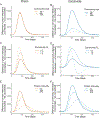Dynamics of Respiratory Infectious Diseases in Incarcerated and Free-Living Populations: A Simulation Modeling Study
- PMID: 35904128
- PMCID: PMC9742162
- DOI: 10.1177/0272989X221115364
Dynamics of Respiratory Infectious Diseases in Incarcerated and Free-Living Populations: A Simulation Modeling Study
Abstract
Background: Historically, correctional facilities have had large outbreaks of respiratory infectious diseases like COVID-19. Hence, importation and exportation of such diseases from correctional facilities raises substantial concern.
Methods: We developed a stochastic simulation model of transmission of respiratory infectious diseases within and between correctional facilities and the community. We investigated the infection dynamics, key governing factors, and relative importance of different infection routes (e.g., incarcerations and releases versus correctional staff). We also developed machine-learning meta-models of the simulation model, which allowed us to examine how our findings depended on different disease, correctional facility, and community characteristics.
Results: We find a magnification-reflection dynamic: a small outbreak in the community can cause a larger outbreak in the correction facility, which can then cause a second, larger outbreak in the community. This dynamic is strongest when community size is relatively small as compared with the size of the correctional population, the initial community R-effective is near 1, and initial prevalence of immunity in the correctional population is low. The timing of the correctional magnification and community reflection peaks in infection prevalence are primarily governed by the initial R-effective for each setting. Because the release rates from prisons are low, our model suggests correctional staff may be a more important infection entry route into prisons than incarcerations and releases; in jails, where incarceration and release rates are much higher, our model suggests the opposite.
Conclusions: We find that across many combinations of respiratory pathogens, correctional settings, and communities, there can be substantial magnification-reflection dynamics, which are governed by several key factors. Our goal was to derive theoretical insights relevant to many contexts; our findings should be interpreted accordingly.
Highlights: We find a magnification-reflection dynamic: a small outbreak in a community can cause a larger outbreak in a correctional facility, which can then cause a second, larger outbreak in the community.For public health decision makers considering contexts most susceptible to this dynamic, we find that the dynamic is strongest when the community size is relatively small, initial community R-effective is near 1, and the initial prevalence of immunity in the correctional population is low; the timing of the correctional magnification and community reflection peaks in infection prevalence are primarily governed by the initial R-effective for each setting.We find that correctional staff may be a more important infection entry route into prisons than incarcerations and releases; however, for jails, the relative importance of the entry routes may be reversed.For modelers, we combine simulation modeling, machine-learning meta-modeling, and interpretable machine learning to examine how our findings depend on different disease, correctional facility, and community characteristics; we find they are generally robust.
Keywords: COVID-19; correctional facility; infectious diseases; meta-model.
Figures





Similar articles
-
Predicting COVID-19 Outbreaks in Correctional Facilities Using Machine Learning.MDM Policy Pract. 2024 Jan 29;9(1):23814683231222469. doi: 10.1177/23814683231222469. eCollection 2024 Jan-Jun. MDM Policy Pract. 2024. PMID: 38293655 Free PMC article.
-
Community-Associated Outbreak of COVID-19 in a Correctional Facility - Utah, September 2020-January 2021.MMWR Morb Mortal Wkly Rep. 2021 Apr 2;70(13):467-472. doi: 10.15585/mmwr.mm7013a2. MMWR Morb Mortal Wkly Rep. 2021. PMID: 33793464 Free PMC article.
-
Inclusive health: modeling COVID-19 in correctional facilities and communities.BMC Public Health. 2022 May 16;22(1):982. doi: 10.1186/s12889-022-13313-7. BMC Public Health. 2022. PMID: 35578258 Free PMC article.
-
Mental health and well-being in prisons and places of detention.Int J Prison Health (2024). 2024 Oct 29;ahead-of-print(ahead-of-print). doi: 10.1108/IJOPH-07-2024-0035. Int J Prison Health (2024). 2024. PMID: 39465264
-
Infection Prevention and Control in Correctional Settings.Emerg Infect Dis. 2024 Apr;30(13):S88-S93. doi: 10.3201/eid3013.230705. Emerg Infect Dis. 2024. PMID: 38561855 Free PMC article. Review.
Cited by
-
Predicting COVID-19 Outbreaks in Correctional Facilities Using Machine Learning.MDM Policy Pract. 2024 Jan 29;9(1):23814683231222469. doi: 10.1177/23814683231222469. eCollection 2024 Jan-Jun. MDM Policy Pract. 2024. PMID: 38293655 Free PMC article.
-
Transmission models of respiratory infections in carceral settings: A systematic review.Epidemics. 2025 Mar;50:100809. doi: 10.1016/j.epidem.2024.100809. Epub 2024 Dec 6. Epidemics. 2025. PMID: 39705867 Free PMC article.
-
Decarceration and COVID-19 infections in U.S. Immigration and Customs Enforcement detention facilities: a simulation modeling study.Lancet Reg Health Am. 2024 Dec 27;42:100971. doi: 10.1016/j.lana.2024.100971. eCollection 2025 Feb. Lancet Reg Health Am. 2024. PMID: 39830893 Free PMC article.
-
Rates of SARS-CoV-2 transmission between and into California state prisons.medRxiv [Preprint]. 2023 Aug 25:2023.08.24.23294583. doi: 10.1101/2023.08.24.23294583. medRxiv. 2023. PMID: 37662306 Free PMC article. Preprint.
-
Emulator-Based Bayesian Calibration of the CISNET Colorectal Cancer Models.Med Decis Making. 2024 Jul;44(5):543-553. doi: 10.1177/0272989X241255618. Epub 2024 Jun 10. Med Decis Making. 2024. PMID: 38858832 Free PMC article.
References
-
- Bick JA Infection Control in Jails and Prisons. Clinical Infectious Diseases 45, 1047–1055 (2007). - PubMed
MeSH terms
Grants and funding
LinkOut - more resources
Full Text Sources
Medical

